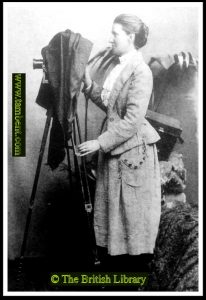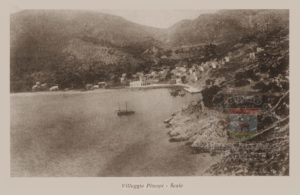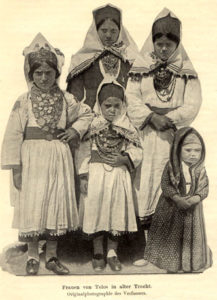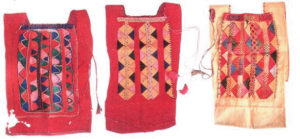
Although from 1885 Mabel Bent came equipped with the latest in cameras, and was appointed expedition photographer to the Bents’ explorations of the Eastern Mediterranean, Africa, and Southern Arabia, very very few of her photographs are published or known – other than what have appeared in their books and articles, or have been transformed into the few Bent lantern-slides remaining in the Royal Geographical Society, London. No doubt more will turn up eventually, e.g. a folder of prints dated to the Bents’ trip to Great Zimbabwe in 1891 seems to exist in the Zimbabwe National Archives, Harare (for those interested in the source, please contact the Bent Archive).

Next best, in the absence of Mabel’s own work, are those images taken by other photographers more or less synchronously. There are several to choose from, but a favourite must be from the Greek Dodecanese, the island of Tilos, between Kos and Rhodes, and a wonderful group of Tilian girls and women taken in the late 1890s, just a dozen years after Theodore and Mabel visited Tilos and the Dodecanese in 1885. The photograph (see below) appears in an article entitled ‘Ein Besuch auf der Insel Telos’ by one Friedrich v. Vincenz (possibly based at the time in Smyrna/Izmir) and published in the popular German magazine ‘Globus’ in January 1900 (pages 46-8). The original article has been scanned, but a comprehensive (and now possibly inactive ?) Tilos website also has a fine page or two reprinting the article (in German, but an English translation is available via the site – which, incidentally, has much else to enjoy: articles, photographs, and an Italian-era map that is not much reproduced). Vincenz’s article will be of interest generally, although some comments are inappropriate today, with antisemitic overtones – such a common feature of the turn of the century, and here and there also in the writings of the Bents. The author does not feature much on-line; he may have been residing at the time in Smyrna/Izmir, but he seems not to have written much, if anything, else, and no images of him pop up.

Focusing now on the evocative Vincenz group photograph, infants to adults, dated around 1900 remember, the women and girls show off their distinctive island finery. The elder ones might easily have met the Bents (perhaps some viewer is related to them? Do write in if you are…), but in 1885 the inhabitants of Tilos were camera-shy, as Mabel records in her diary: ‘… all the women here are terrified at the idea of being photographed and my camera is rather a “white elephant”’. Friedrich v. Vincenz had more luck (his article also features a photo of a local priest).
Mabel was always passionate about costumes and local dress. Her description of Tilian attire fits so well with the photo (as she writes in her diary at the end of February, 1885): “The men dress the same as all the other islanders we have seen, but the women look very like Laps. They wear a very rational dress. A shirt which comes a little below the knee, embroidered all round with red and green. Over this a light brown coat is wrapped by a scarlet belt. The shirt has a small square sailor collar of yellow and the open front of the shirt is filled with a piece of coloured embroidery, almost hidden by the great number of necklaces of different colours composed of numerous strings of glass beads, reaching nearly to the waist. On their heads they wear red pointed caps of red cloth with a bit of gold braid straight up the front and down the back. A handkerchief with the point turned up is tied across the front, and the hair, which is plaited rather high in front, is brought low over the ears and behind below the cap. Over all they tie a towel by its 2 front corners and sometimes also by the 2 back ones…” (Mabel and Theodore Bent, ‘The Dodecanese, or Further Travels Among the Insular Greeks’, Oxford, 2015, page 114).

Mabel’s reference to the ‘open front of the shirt… filled with a piece of coloured embroidery’ is noteworthy. This piece of embroidery is the τραχηλιά (‘trahilia’), presumably developed and designed to facilitate breastfeeding. Friedrich v. Vincenz also describes it: ‘Auf der Brust befindet sich ein vom Halse mehr oder weniger tief herabreichender Ausschnitt, der durch bunte kunstreiche Stickerei, meist in Schwarz, Rot und Grün, ausgefüllt ist, auf dem die mit großer Vorliebe getragenen Schaumünzen, sowie bunten Halsgehänge in Glas und Bernstein hängen.’
The Tilos website already mentioned above also has a delightful page (several years old now and perhaps no longer updated?) describing the three examples shown above, as well as photographs and stories of venerable matriarchs. [If any of the site’s contributors would care to get in touch, we would be delighted to acknowledge them, rectify any errors, and thank them for such interesting material (July 2019).]
Those interested in the Bents and Tilos are directed to ‘The Dodecanese, or Further Travels Among the Insular Greeks’, Oxford, 2015 (locals [2019] can hop on a ferry and get a copy from Rhodes’ Akademia Bookshop).
Mabel Bent’s collected Greek and Turkish Chronicles are available via Archaeopress, Oxford.
 Leave a comment or contact us about this article
Leave a comment or contact us about this article